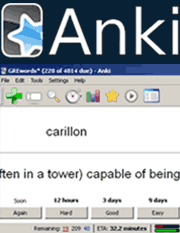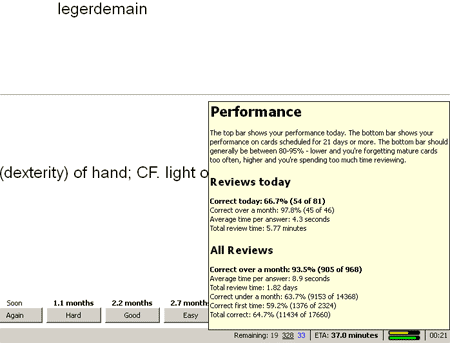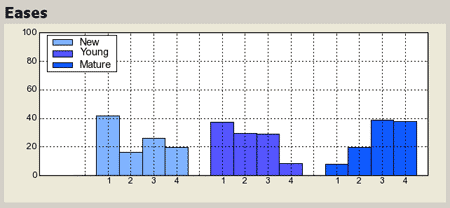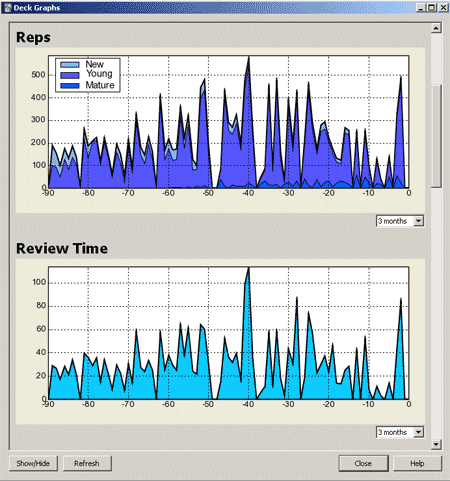 A couple months back, Tim Ferriss’s twitter mentioned this article: Want to Remember Everything You’ll Ever Learn? It was a piece about a memorization program called SuperMemo and its genius creator. The theory the behind the software is for better memorization, the best time to recall something is right before you’re about to forget it. This is better than blind repetition because you don’t waste time repeating things you already know and, just as importantly, the delayed recall helps develop a deeper memory of the information to be remembered (because it gives time for the user to move it from short-term to long-term memory). I’ve been using a program called Anki and am quite pleased with the results. Download and try it yourself.
A couple months back, Tim Ferriss’s twitter mentioned this article: Want to Remember Everything You’ll Ever Learn? It was a piece about a memorization program called SuperMemo and its genius creator. The theory the behind the software is for better memorization, the best time to recall something is right before you’re about to forget it. This is better than blind repetition because you don’t waste time repeating things you already know and, just as importantly, the delayed recall helps develop a deeper memory of the information to be remembered (because it gives time for the user to move it from short-term to long-term memory). I’ve been using a program called Anki and am quite pleased with the results. Download and try it yourself.
Background:
Prior to this I had been using several websites as study tools. In Thailand I was using Number2.com for vocabulary building. During the months there I managed to go through their entire collection of ~2500 words. It’s a wonderful (and free) resource that I’d recommend without hesitation. However, I wasn’t too sure of whether I really learned these words, because when I started repeating them, I would miss quite a few.
My next favorite was Quizlet. I was using Quizlet for both vocabulary learning and building up chemistry knowledge. Quizlet is great because there are thousands of lists already made, but you can also build your own. Also Quizlet lets you play a space-invader-like game and has performance based quizzes. I found it really effective. My only issue with it was it was a bit time consuming typing out the full definition or equation during the review games.
My friend and I were both planning to take our GMAT/GRE’s in the near future and wanted a study tool that would help us with the vocabulary. I was in the process of writing a system when I read the SuperMemory article via Tim’s Twitter Page. I was super excited that there was no need to reinvent the wheel! I couldn’t go to bed before giving it a shot.
Initial SRS (Spaced Repetition System) Testing:
After reading reviews and checking the wikis on spaced repetition and SuperMemo, I tried a few systems: SuperMemo, Mnemosyne, Anki, and a few other web-based tools like Crammage.com.
The big advantage of the programs over the web-based tools was that I could practice offline and I could create cards and lists more easily. I quickly chose Mnemosyne over SuperMemo (even though SuperMemo is the original) because I liked the cleaner, easier to understand UI. I used it for a few days and liked it.
The next task was creating subsets and switching between them. I like clean look and feel of Mnemosyne, but I couldn’t figure out how to import one of my study lists. I know the program has that capability and I’m sure it would be quite easy after taking fifteen minutes to find out how to do it, but I figured it’d be even easier and faster to give the Anki program a shot.
I was right. With Anki, the interface was just as clean and intuitive, but I managed to import a list of terms and definitions without reading any of the instructions or FAQ. So, by quick (and brutal) default, Anki was my program of choice.
How Anki Works:
Anki is a simple flash card program. You choose how many cards and minutes a day you want to study. Then you start your study session:
1. Anki shows you a term
2. You try to remember the definition
3. You click space bar (or the “Show Answer” button)
4. You click 1 (Again), 2 (Hard), 3 (Good), 4 (Easy)
Based on your response and your past history with the card, Anki chooses when to show the card again. For example, an “Again” card may appear in a few minutes, while an “Easy” card may appear after a week. Each time you successfully review and remember the card that length of time increases. So if you learn a word, you’d review it a day later, than a few days later, than a week, a few weeks, and into the months.
More Anki Features:
In addition to Anki’s simplicity, the program actually offers many useful features. It was originally created for studying Japanese (hence the name) and has flashcard layouts conductive to multiple written systems. One can also post pictures and sounds into their sets (great for various curves/relationships in econ). As with Mnemosyne, there are plenty of pre-made decks available in a wide variety of languages and subjects, and their website is run as a MediaWiki, so one can easily contribute. I put up my Mnemosyne Spanish deck within a few days. They also have easy to follow videos, easy enough for friends and parents to follow without asking for your help.
Since I started using the program there have been several updates, none of them gave me problems. Like the automatic updates, you can create an account on their site and have your computer sync your decks before/after your study sessions. This lets you update your study decks on multiple computers, and lets you study from remote computers via their online interface.
The coolest thing about Anki, however, is their stats. I can see charts on my progress. When I started using the program I decided I’d give it a few months and see how it goes before posting anything up. Below are some of the results.
A Few Months On Anki’s Spaced Repetition System:
I used a large set to measure performance. My setup settings vary between 30 and 50 cards and an hour limit per day. The overall results were 905 out of 968 (93.5%) words correct over a month and a total review time of 1.8 days (~41 hours).

The screenshot above shows quite a few parts of the program.
On the left, you see the definition term on top and the definition answer on the bottom.
Below are the four recall performance options with the length of time the program will wait before repeat.
To the right are my performance stats.
Below them are session stats: 19 wrong, 328 old cards to review, and 33 new cards. An ETA of how long is left in the session. The top yellow bar shows progress with short term words, the bottom bar shows progress in the long term. To it’s right is a timer for the current card.

Above are stats on the daily eases. These are neat because they show how the learning is going on. 1 means Repeat (Don’t Know), 2 is Hard, 3 is Good, and 4 is Easy. Notice the shift to Good/Easy in the longer term words.

Above are stats on the amount of time and cards reviewed over the past three months. Unfortunately, the past few days have been more hectic, with less practice, but I’ll catch up this week.
Conclusion:
Anki is a great program that helps you learn better and faster. Check it out for yourself at: http://ichi2.net/anki/.